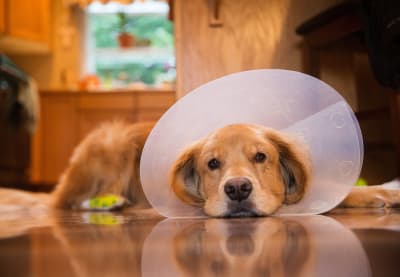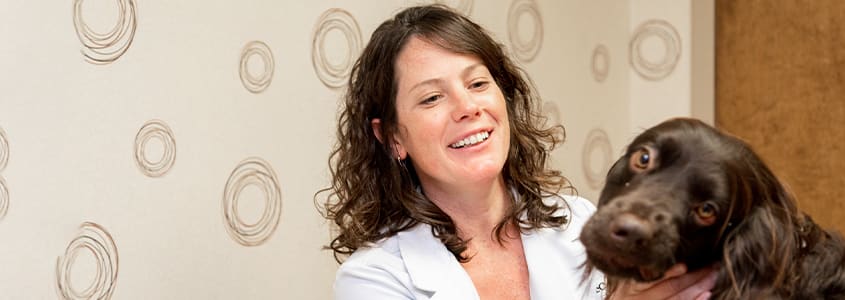Always Follow Post-Op Instructions
Both pets and pet parents are bound to feel some stress around the time of the procedure, but knowing how to care for your furry friend after they return home is imperative to helping your pet get back to themselves as quickly as possible.
After your pet's surgery, the vet will give clear and detailed instructions regarding how to care for your pet at home. It’s essential to follow these instructions carefully. If there are any steps you do not understand, be sure to ask.
Even if you get home and realize you’ve forgotten how to complete a specific instruction, give your vet a call to clarify. Our team of veterinary professionals at Guilford-Jamestown Veterinary Hospital want the very best for your pet. We are always happy to help you understand the post-op instructions provided.
Typical Recovery Times for Pets After Surgery
We find that pets tend to recover from soft tissue procedures such as abdominal surgeries, spaying or neutering more quickly than operations involving ligaments, bones and joints. Many soft tissue surgeries typically heal about 80% after 2 to 3 weeks, and take about 6 weeks to completely heal.
For surgeries involving ligaments and bones, recovery may take much longer - 80% recovery will usually occur about 8 to 12 weeks in, though may take as long as 6 months for complete recovery, such as when a torn cruciate ligament (ACL) has been repaired.
Here are a few vital tips to help you keep your pet content and comfortable as they recover at home:
Effects of General Anesthetic
Your vet will likely have used general anesthetic during the surgical procedure. The anesthetic renders your pet unconscious and prevents them from feeling any pain during the procedure, but it can take some time to wear off after the surgery is complete.
General anesthetic may temporarily cause sleepiness, or make your pet feel shaky on their feet. These are normal after effects and should disappear quickly with a little rest. Temporary lack of appetite is another common side effect attributed to general anesthesia.
How to Feed Your Pet After Surgery
After your vet administers the general anesthetic, your pet may feel somewhat nauseated and lose their appetite. When feeding your pet after surgery, try offering a half-size portion of a light meal such as rice and chicken, which may be easier to digest than regular store-bought pet food.
Your pet’s appetite should return within about 24 hours following surgery. They can then gradually start to eat their regular food. If you find that your pet’s appetite hasn’t returned within 48 hours, contact your veterinarian or veterinary surgeon. Loss of appetite can be a sign of infection or pain.
Managing a Pet’s Pain After Surgery
Before you and your pet head home after surgery, a veterinary professional explain any medications or pain relievers they have prescribed for your pet so you can manage post-surgery pain or discomfort.
They will explain the dose needed, how often you should provide the medication, and how to safely administer the meds. Be sure to follow these instructions carefully to prevent any unnecessary pain during recovery and to eliminate the risk of side effects. If you are unsure about any instructions, ask follow-up questions.
Pain medications and/or antibiotics are often prescribed for pets after surgery to help relieve discomfort and to prevent infections following the procedure. If your pet experiences anxiety or tends to be on the high-strung end of the spectrum, your vet may also prescribe an anti-anxiety medication or sedative to help your pet stay calm while healing.
Never provide your pet human medications without first consulting your veterinarian. Many drugs that help us feel better are toxic to our four-legged friends.
Helping Your Pet Stay Comfortable At Home
After surgery, it’s important to give your pet a quiet, comfortable place to rest, away from the hustle and bustle of the house, other pets and children. Setting up a comfortable, soft bed and allowing them lots of room to spread out can help to prevent undue pressure on any parts of their body that may be sensitive or bandaged.
Restricting Your Pet’s Movement
After your pet’s surgery, your vet will likely recommend limiting your pet’s movement and physical activity for a specified period. Sudden jumping or stretching can disrupt the healing process and may even cause the incision to reopen.
Fortunately, most procedures will not require significant confinement such as complete ‘crate-rest’ (cage-rest) to help your pet recover, and most pets will cope well staying indoors for a few days, taking only the odd essential trip outside for bathroom breaks.
However, you may find it difficult to keep your dog from climbing stairs or jumping up on furniture they love to sleep on. Preventing these actions for a few days may require keeping your dog in a safe, comfortable room of the house when you are unable to directly supervise them.
Helping Your Pet With Cage-Rest
While most surgeries will not require cage-rest, if your pet has had orthopedic surgery, part of recovery will involve strictly limiting his or her movements. If your vet recommends cage-rest for your pet after surgery, there are measures you can take to help your pet adjust to the strict confinement so they feel more comfortable with spending long periods in a crate.
Confirm that the crate is large enough to allow your pet to stand up and turn around. You may need to purchase a larger crate if your dog has a plastic cone or e-collar to prevent licking. Don’t forget to make sure he or she has plenty of room for their water and food dishes, without risking spills that may cause bandages or bedding to become wet and soiled.
Caring for Your Pet’s Stitches
You may notice stitches have been placed on the inside of your pet’s wound rather than the outside. Stitches on the inside will dissolve as the incision heals.
If staples or stitches have been used on the outside, your vet will typically need to remove them approximately 10 to 14 days after surgery. Your vet will let you know which type of stitches he or she used to close your pet’s incision, and about any follow-up care that will be required.
The Incision Site
You may find it challenging to prevent your pet from scratching, chewing, biting or otherwise bothering their incision site or bandages. A cone-shaped plastic Elizabethan collar (available in both soft and hard versions) is an effective option to prevent your pet from licking their wound.
Many pets adapt to the collar relatively quickly, but if your pet is struggling to adjust, other choices are available. Ask your vet about less cumbersome, more effective products such as post-op medical pet shirts or donut-style collars.
Keep Your Pet’s Bandages Dry
Ensuring bandages are dry at all times is another critical step to helping your pet’s surgical site heal quickly.
If your pet walks around or goes outside, ensure the bandages are covered with cling wrap or a plastic bag to prevent wet grass or dampness from getting between the bandage and their skin. When your pet returns inside, remove the plastic covering, as leaving it on may cause sweat to build up under the bandage, leading to infection.
Attend Your Pet’s Follow-Up Appointment
The follow-up appointment allows your vet a chance to monitor your pet’s recovery progress and look for any signs of infections before it develops into a serious condition.
It’s also key to change your pet’s bandages at the right time, as leaving them on for too long can cause pressure sores or cut off blood supply. The veterinary team at Guilford-Jamestown Veterinary Hospital have been trained to correctly dress wounds. Bringing your pet in for their follow-up appointment allows this process to happen - and for us to help keep your pet’s healing on track.
Note: The advice provided in this post is intended for informational purposes and does not constitute medical advice regarding pets. For an accurate diagnosis of your pet's condition, please make an appointment with your vet.
Concerned about your pet's recovery from recent surgery? Contact our Greensboro vets for advice or answers to your questions. Our veterinarians are here to help your pet feel better.
Looking for a vet in Greensboro?
We're always accepting new patients, so contact our veterinary hospital today to book your pet's first appointment.
Related Articles View All
How much does an emergency vet visit cost?
Emergency veterinary care can be costly, but planning ahead allows you to make decisions about your pet's care based on their needs rather than financial restrictions. Today, we look at the cost of emergency vet care, and how to be ready if your pet needs emergency treatment.
Does my cat have asthma?
The treatment for asthma in cats can seem daunting for many pet parents. But your veterinarian can lead you through the diagnosis and treatment process, to help get your cat breathing easier.
Cat Paralysis - What You Need to Know
What is cat laryngeal paralysis? How is it different from full or partial paralysis in cats? Today you will learn about types of paralysis that can impact the health and well-being of your cat.
Kidney Failure in Dogs
Chronic and acute kidney failure are serious health problems commonly seen in dogs. Here, you will learn about the differences between chronic and acute kidney failure in dogs, the signs to watch for and how these conditions are treated.


